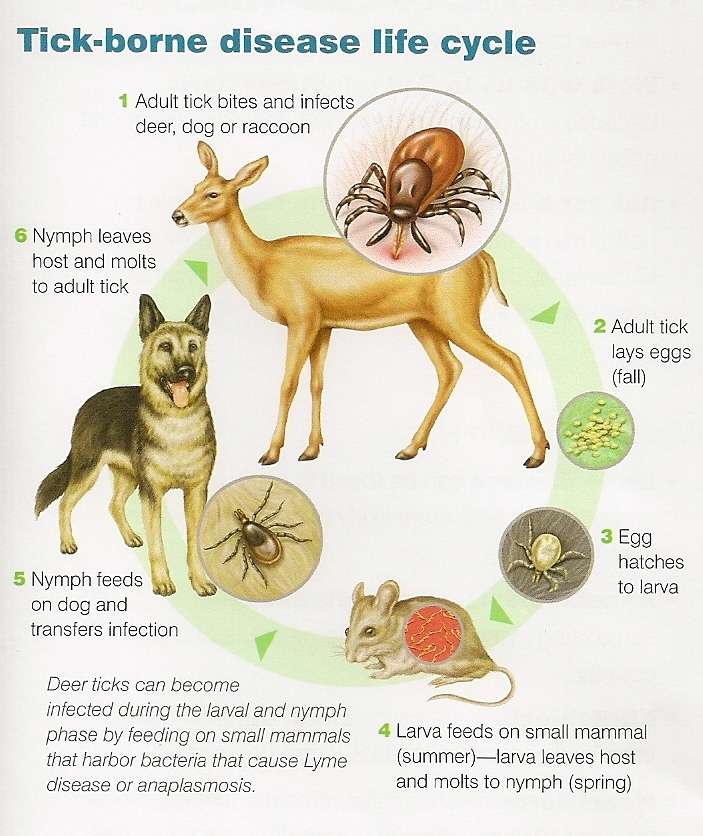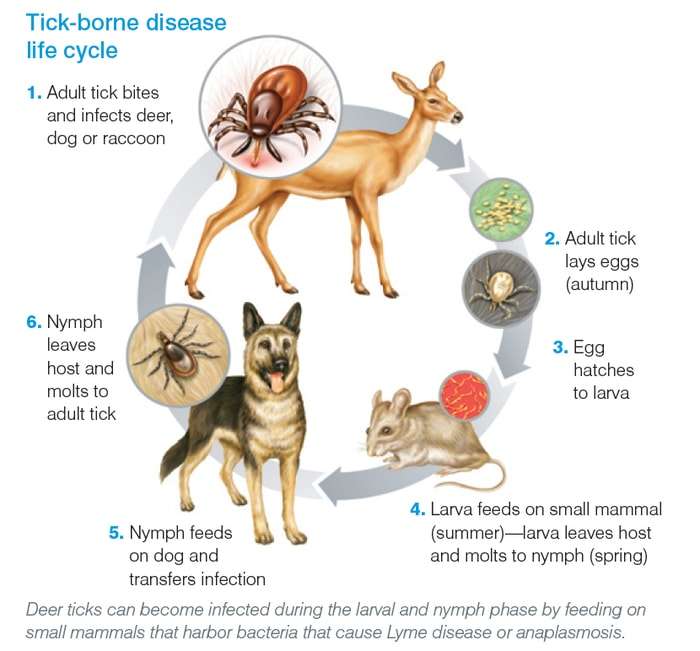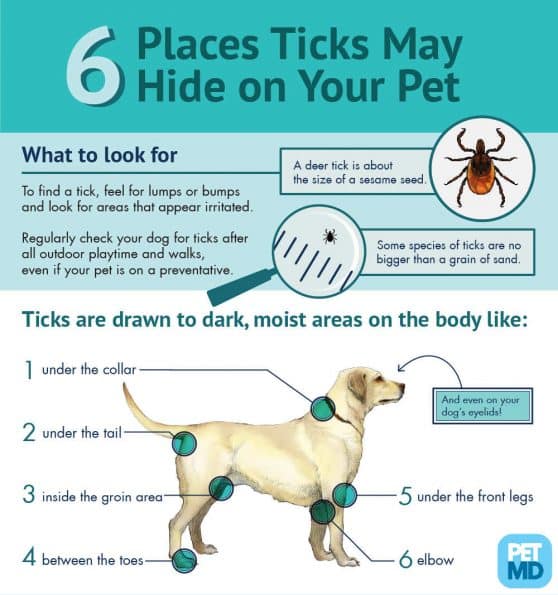What Happens If Lyme Disease Goes Untreated
Treating Lyme disease in a timely manner is absolutely crucial to your dogs health, otherwise its complications can cause even more severe problems. Dr Muller further warns, Lyme disease can lead to serious damage of the heart, nervous system, and kidneys.
Dogs who are not treated for Lyme disease may find themselves with any of the following conditions:
- Inflammation of the kidneys, and in severe cases, kidney failure. Symptoms of this kidney failure include increased thirst and urination, vomiting, diarrhea, swelling of extremities, and lack of appetite. This can be fatal.
- Chronic pain from arthritis
- Seizure disorders or facial paralysis as a result of damage to the nervous system
Many of these issues, if left untreated, can be potentially fatal, so the answer is clear. If your dog is diagnosed with Lyme disease, take care of it as soon as you possibly can.
Can You Prevent Lyme Disease In Dogs
The best way to prevent Lyme disease in your dog is by protecting them against infected ticks.
Adequate flea and tick prevention is essential in preventing tick-borne illness, as an approved tick repellent will prevent the tick from attaching long enough to spread disease.
You can speak with your vet about which tick prevention is best for your furry friend at your next wellness exam.
Not only is flea and tick prevention essential in preventing tick-borne illness, but so is avoidance of areas that are known to harbor a large amount of ticks.
Some of the most high risk areas include any regions with tall foliage, as this is the easiest way for a tick to come in contact with your dogs fur.
Not only should you avoid these areas when possible, but you should always search your dogs fur for any ticks after your outdoor adventures.
If you live in an area with a high rate of Lyme disease infections, you can speak with your veterinarian about the Lyme disease vaccine for dogs.
The vaccine is not 100% effective, meaning its important to have your dog on tick prevention in addition to administering the vaccine.
Treating Asymptomatic Lyme Disease In Dogs
If your dog has tested positive for Lyme disease and isnt showing any symptoms, you may be wondering why you need to treat them for the disease. After all, if your dog cant give you Lyme disease and they arent showing any signs of having it, why treat them?
The answer is in how Lyme disease attacks the body. Even if the dog isnt currently showing symptoms of Lyme disease, that doesnt mean they wont eventually start developing symptoms. And if Lyme disease is allowed to ravage the body unchecked, the symptoms that eventually show up can be worse than any mild obvious symptoms, such as kidney damage.
Read Also: Are Hives A Symptom Of Lyme Disease
Everything You Need To Know About Lyme Disease In Dogs
To keep the lights on, we receive affiliate commissions via some of our links. Our review process.
Lyme disease is a fairly common illness in dogs, just as it is in humans. And cases continue to rise in both species every year. Despite widely available preventative measures for dogs, the Companion Animal Parasite Council reported that confirmed cases in the U.S. rose over 43% between 2017 and 2021.
Heres everything you need to know about spotting the symptoms, preventing, diagnosing, and treating this expensive tick-borne illness. Symptoms can take months to develop so its important to keep an eye on your pup long after a tick bite.
My Dog Tested Positive For Lyme Disease: Now What

This spring, dog owners may have noticed that we are using a different heartworm test this year. The test is called a 4DX and it detects antibodies to heartworm plus the tick borne diseases Lyme, Erlichia, and Anaplasma.
It can be scary and confusing to get positive results, so Id like to take a few posts to go over what positive results on theses tests mean and what we recommend doing about them. This post will focus on Lyme.
First: Dont panic! A positive Lyme test does not necessarily mean your dog has an active Lyme infection right now requiring treatment. It means that at some point your dog has been exposed to the Lyme organism and produced antibodies. The test does not tell us if the exposure was recent or in the past or whether your dog requires treatment.
How do we tell the difference? Primarily by whether your dog is currently showing symptoms of Lyme disease or not and some additional testing. Only about 5% of dogs exposed to Lyme disease will become sick the rest successfully fight the bacteria off and show no or very mild symptoms. Symptoms of Lyme disease may wax and wane and include lethargy, high fever, loss of appetite, lameness , and enlarged lymph nodes.
If most dogs dont get sick from exposure to Lyme and a positive test doesnt necessarily mean a dog needs treatment, why do we do it or care about a positive test? There are a few reasons:
Soooo after all of that, what do we actually DO if a dog tests positive?
Karen Christopherson DVM CVA
Read Also: What Happens If Lyme Disease Is Untreated
Dog Lyme Disease Test
The Serology test looks for enzymes in the blood associated withLyme disease. The problem is that there are two types of vaccines. The ELISA test can tell if yourdog has the disease only if it has not been vaccinated or it if had thesubunit vaccine. If your pet had the whole cell the test cannot tell ifyour dog has the disease or a reaction to the vaccination itself.
A newer test called the Canine SNAP 3Dx or the C6 SNAP test. It isdone in your Veterinarians office and if positive a follow-up test isdone and sent to a lab to confirm the findings.
You May Like: What Are The Long Term Symptoms Of Lyme Disease
Is Lyme Disease In Dogs Curable
You just found out that your furry companion has tested positive and been diagnosed with Lyme disease. Youre concerned about your dog and want to know everything there is to know about their condition. How long does it last?, What are the symptoms?, and Can Lyme disease in dogs be cured? are most likely the main questions that pet owners will ask.
If you find yourself in this position and are worried about your four-legged friend, stay calm. While it is critical that you learn everything about the condition, it is also important to understand the next necessary steps to take once they have been diagnosed to improve your dogs health.
One of the biggest concerns among pet owners is whether Lyme disease in dogs is curable. Just know that this disease can be cured as long as the dog has received proper treatment at an early stage. However, it is crucial that you as the dog owner understand the ins and outs of this disease in order to treat it and get your dog back to living his normal and happy life.
Also Check: Chances Of Lyme Disease After Tick Bite
How Do You Prevent Lyme Disease In Dogs
To prevent Lyme disease in dogs, try to avoid tick-infested areas, especially during peak season. When you come in from the outdoors, check your dogâs body and carefully remove any ticks with tweezers.
Year-round tick control helps in prevention. You can also ask your vet about tick-preventive products. These products kill ticks on your dogâs body before they have a chance to spread an infection. Vaccines can also help prevent Lyme disease in dogs, but vets warn against them unless you live in an area that is prone to ticks.
Show Sources
How Long Do Lyme Disease Flare Ups Last In Dogs
Generally, Rocky Mountain Spotted Fever in dogs lasts about two weeks, but severe cases could be fatal. Symptoms of this disease include abdominal pain, coughing, lack of appetite, depression, fever, vomiting, diarrhea, stiffness, neurological problems, swelling of the legs or face, and skin lesions.
Recommended Reading: How Do You Get Chronic Lyme Disease
How Can I Tell If Treatment Is Working
If joint lameness is the presenting sign, improvement may be noted after 3-5 days starting antibiotics. A dog’s response to therapy can be assessed by repeating the QC6 test six months after treatment is complete. Dogs that start with a moderate to high QC6 value typically show a 50% reduction or more in the QC6 at six months, indicating that treatment has been successful. Dogs that have a lower initial QC6 value may not show such dramatic reductions in the QC6 at six months, although the value should still be lower than the starting point if treatment has been successful.
A persistently high QC6 suggests treatment may not have been complete or that the dog became reinfected after treatment was stopped.
Is There A Vaccine For Lyme Disease In Dogs
Yes. Your veterinarian may recommend the Lyme vaccine if your dog lives in a high-risk area or is in high-risk situations regularly. Like all vaccines, the Lyme vaccine is not 100 percent effective. Even with vaccination, your dog will still need monthly preventatives, and you should still take other preventative measures, like avoiding areas with ticks and manually checking your dog for ticks.
Read Also: Jobs In Old Lyme Ct
Summary Of Lyme Disease In Dogs
Lyme disease is transmitted via tick bites, and can cause lameness, swollen joints and even kidney failure. While it can be treated if the case is not too severe, prevention is best. The best way to prevent an infection is to reduce your dogs exposure to ticks and stay up-to-date on monthly preventatives and Lyme vaccinations.
How Long Do Symptoms Take To Present Themselves

Like many medical conditions affecting dogs, Lyme disease isnt always apparent early on. In fact, it can take 2-5 months for your dog to begin showing symptoms of Lyme disease, and it may take even longer for some animals.
Another thing to keep in mind is that 5-10% of dogs who have Lyme disease dont actually show any signs of it.3 While you might notice behavioral changes and other symptoms that indicate your dog has Lyme disease, theres a good chance that you wont notice any symptoms at all. This is one of the reasons its so important to take your dog to the vet for a checkup every once in a while.
Don’t Miss: Can You Donate Blood With Lyme Disease
Which Ticks Carry Lyme Disease
Though many different species of ticks can carry infectious agents, not all ticks will carry Lyme disease.
The most common species of tick that carries Lyme disease in the United States is the black-legged tick, or most commonly known as the deer tick.
These ticks can be found in varying sizes based on their life stage, with some being as small as a pinpoint.
Because of this, these types of ticks can be hard to spot on your pup.
What Is Canine Lyme Disease
The risk for you and your pet specifically dogs of contracting Lyme disease is increasingly on the rise across areas of Ontario.
Incidence of Canine Lyme Disease easily keeps pace with the increased incidence of the disease in humans, and probably more. Although likely true that the incidence of Lyme disease is higher in dogs than humans, there is no national or provincial system for capturing the incidence of Canine Lyme Disease.
Lacking a national or provincial system for tracking, reviewing the human data for Lyme disease is important as an indication of the exposure and potential infection in dogs.
A Ticks Life
Ticks dont fly, jump or blow around with the wind. They are sluggish and lumbering and can be as small as a poppy seed. Bites are usually painless, so you or your pet may not know that theres been a bite.
Don’t Miss: Do You Have To Fast For Lyme Disease Blood Test
Treatment For Lyme Disease In Dogs
While treatment for Lyme disease in dogs is a straightforward course of antibiotics, Lyme disease requires a long form of treatment. This means that if they test positive, your dog will have to undergo Lyme treatment for up to four weeks before theyre cleared of the infection.
There are two major forms of antibiotics used to treat Lyme disease in dogs:
These two broad spectrum antibiotics are used to treat a wide range of illnesses. Its important to remember that whenever your dog is prescribed antibiotics, the antibiotics should be used until the medicine is gone even if the dog shows signs of improvement before that. This helps the antibiotics to drive out every last bit of the infection and prevents a resurgence later.
Preventing Lyme Disease In Dogs
If possible, keep your dog away from tick-infested environments where Lyme disease is common.
Check your dogs coat and skin daily to make sure you find any ticks hiding on your pet, and remove ticks by hand.
The most effective way to prevent Lyme disease and protect pets from other tick-borne diseases is to use flea and tick prevention.
Your veterinarian can prescribe a variety of prescription flea and tick options, including collars, topical solutions, and tablets and chews that kill and repel ticks. These products should be used under a veterinarian’s supervision and according to the label’s directions.
If you live in an area where ticks are abundant, Lyme vaccines are available. However, not all dogs are a good candidate for the vaccine. Talk to your veterinarian to see if the Lyme vaccination is right for your dog.
References:
1. Lyme Disease. Companion Animal Parasite Council. https://capcvet.org/guidelines/lyme-disease/.
2. Littman MP, Gerber B, Goldstein RE, Anna M, Michael L, George RL. ACVIM consensus update on Lyme borreliosis in dogs and cats. J Vet Intern Med. 2018 :887-903. doi:10.1111/jvim.15085
Don’t Miss: Best Lyme Disease Doctors In The Us
What To Do If My Dog Has A Tick
Despite all your best efforts, sometimes a tick will still take hold of your pooch. If your dog has a tick, then you will want to remove it as soon as possible.
To remove, follow these steps:
So Do Dogs Get Lyme Disease
Yes. Although, for reasons that we dont fully understand, they seem to be less susceptible than we are to the infection. Most dogs are asymptomatic, with less than 5-10% of infected dogs developing symptoms3. Even so, those that do develop clinical signs can become very poorly.
The most common symptoms in dogs resemble those in human patients, including fever, lethargy, and poor appetite. Funnily enough, dogs dont get erythema migrans, so a skin rash in a dog is unlikely to be Lyme disease. However, they frequently get very painful joints, making them reluctant to move or cause them to limp, which is often the reason an owner will take their dog to be checked by the vet.
Rarely, some dogs with Lyme disease can develop severe inflammation of the kidneys, which can be life-threatening. Data from the USA suggests retriever breeds and their crosses seem to be more at risk of this complication4.
You May Like: What Is Chronic Lyme Disease In Humans
You May Like: Tick Bites That Cause Lyme Disease
Signs Your Dog Has Lyme Disease
Ticks can cause all kinds of problems for dogs, but Lyme disease is one of the most serious. When a dog is infected with Lyme disease, you may notice that they are lethargic and running a fever. Other symptoms include joint pain and loss of appetite. Leg and body pain may also be present, and swollen lymph nodes are also a possibility. These symptoms may cause your dog to be more still than normal or walk with a stiff, painful gait.
Symptoms may seem to vanish only to reappear later. Lyme disease has many long-term effects, and it is a difficult disease to diagnose because the symptoms dont stand out in any way. To diagnose Lyme disease, your veterinarian will ask you about the possibility of tick exposure and watch any symptoms, as well as complete diagnostic testing. Once your dog has been properly diagnosed, your veterinarian will provide you with treatment options.
Since all dog breeds are susceptible to Lyme disease, it is a good idea to use flea and tick preventatives year-round, especially if you take your dog hunting or on other outdoor adventures. In addition, it is a good idea to get your pooch vaccinated against Lyme disease.
Body Language
Lyme disease symptoms that you need to watch for include:
Other signs your dog may have Lyme disease include:
- Noticable Tick Bites
- Swollen And Sore Joints
What Are The Symptoms Of Lyme Disease

Dogs can display several forms of Lyme disease, but the most common symptoms are lameness, swollen lymph nodes, joint swelling, fatigue, and loss of appetite. In addition, serious kidney complications have been associated with Lyme disease in dogs.
Clinical signs of Lyme disease in horses include shifting-leg lameness, generalized stiffness, hypersensitivity to touch, weight loss, and poor performance. Sometimes, the bacteria can infect the central nervous system, leading to neurologic symptoms.
You May Like: When Do Symptoms Of Lyme Disease Start